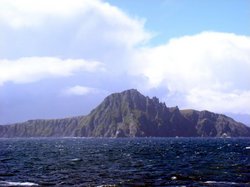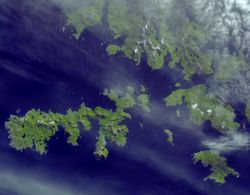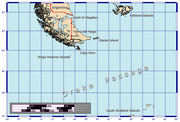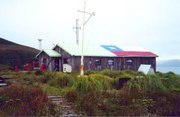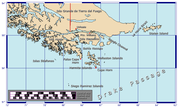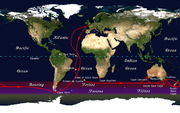Cape Horn
2007 Schools Wikipedia Selection. Related subjects: Central & South American Geography
Cape Horn (Dutch: Kaap Hoorn; Spanish: Cabo de Hornos; named for the city of Hoorn in the Netherlands) is the southernmost headland of the Tierra del Fuego archipelago of southern Chile. It is widely considered to be the southern tip of South America. Cape Horn is the most southerly of the great capes, and marks the northern boundary of the Drake Passage; for many years it was a major milestone on the clipper route, by which sailing ships carried trade around the world. However, the waters around the cape are particularly hazardous, due to strong winds, large waves, and icebergs; these dangers have made it notorious as a sailors' graveyard.
Today, the Panama Canal has greatly reduced the need for cargo ships to travel via the Horn. However, sailing around the Horn is widely regarded as one of the major challenges in yachting, and a number of recreational sailors continue to sail this route, sometimes as part of a circumnavigation of the globe. Several prominent ocean yacht races, notably the Vendée Globe, sail around the world via the Horn, and speed records for round-the-world sailing follow the same route.
Geography
Cape Horn is the southernmost point of land closely associated with South America; it is located at , on Isla Hornos the Hermite Islands, at the southern end of the Tierra del Fuego archipelago. It marks the north edge of the Drake Passage, the strait between South America and Antarctica. The dividing line between the Atlantic and Pacific oceans runs along the meridian of Cape Horn, from Tierra del Fuego to the Southern Ocean.
Cape Horn was originally given the Dutch name "Kaap Hoorn", in honour of the Dutch city of Hoorn; in a typical example of false friends, the Horn became known in English as "Cape Horn", and in Spanish as "Cabo de Hornos" (which literally means "Cape of Ovens"). It is commonly known to sailors simply as The Horn.
The cape is widely considered to be the southernmost point of South America; it is not a true cape of the American mainland, however, as it is actually situated on a small island, Hoorn Island (Isla Hornos), which is the most southerly of the Hermite Islands. (The southernmost point on the South American mainland is Cape Froward; the southernmost point of land on the continental shelf of South America is in the Diego Ramirez Islands.) A cape on nearby Hoste Island, 56 kilometres (35 mi) to the northwest, is called False Cape Horn, as sailors approaching from the west would see it in a similar configuration to the real Cape Horn; since the Wollaston Islands are due east of the false cape, this mistake caused several shipwrecks.
The cape lies within Chilean territorial waters, and the Chilean Navy maintains a station on Hoorn Island, consisting of a residence, utility building, chapel, and lighthouse; the navy supports a lighthouse keeper and his family (the only residents of the island). A short distance from the main station is a memorial, including a large sculpture featuring the silhouette of an albatross, in honour of the sailors who died while attempting to "round the Horn". The terrain is entirely treeless, although quite lush due to the frequent precipitation.
Climate
The climate in the region is generally cool, due to the southern latitude. There are no weather stations in the group of islands including Cape Horn; however, a study in 1882-1883 found an annual rainfall of 1,357 millimetres (53.42 in), with an average annual temperature of 5.2 °C (41.4 °F). Winds were reported to average 30 kilometres per hour (19 mph), with squalls of over 100 kilometres per hour (62 mph) occurring in all seasons.
Contemporary weather records for Ushuaia, 146 kilometres (91 mi) north, show that summer (January–February) average temperatures range from highs of 14 °C (57 °F) to lows of 5 °C (42 °F); in winter (July), average temperatures range from 4 °C (40 °F) to −2 °C (29 °F). Cloud cover is generally high, with averages from 5.2 eighths in May and July to 6.4 eighths in December and January. Precipitation is high throughout the year: the weather station on the nearby Diego Ramirez Islands, 109 kilometres (68 mi) south-west in the Drake Passage, shows the greatest rainfall in March, averaging 137.4 millimetres (5.41 in); while October, which has the least rainfall, still averages 93.7 millimetres (3.69 in). Wind conditions are generally severe, particularly in winter. In summer, the wind at Cape Horn is gale force up to 5% of the time, with generally good visibility; however, in winter, gale force winds occur up to 30% of the time, often with poor visibility.
Political
Cape Horn is part of the commune of Cabo de Hornos (formerly Navarino), whose capital is Puerto Williams; this in turn is part of Antártica Chilena Province, whose capital is also Puerto Williams. The area is part of the Magallanes y la Antártica Chilena Region of Chile.
The Argentine city of Ushuaia is the major municipality in the region, with a population of 50,000; Puerto Toro, a few miles south of Puerto Williams, is the closest town to the cape, and the southernmost town in the world. Depletion of the ozone layer is a significant problem for residents of the region, as the tip of South America is far enough south to be affected by the Antarctic ozone hole.
Sailing routes
There are a number of potential sailing routes around the tip of South America. The Strait of Magellan, between the mainland and Tierra del Fuego, is a major — although narrow — passage, which was in use for trade well before the Horn was discovered; the Beagle Channel, between Tierra del Fuego and Isla Navarino, offers a potential, though difficult route; and there are various passages around the Wollaston and Hermite Islands to the north of Cape Horn.
All of these, however, are notorious for treacherous williwaw winds, which can strike a vessel with little or no warning; given the narrowness of these routes, there is a significant risk of then being driven onto the rocks. The open waters of the Drake Passage, south of Cape Horn, provide by far the widest route, at about 650 kilometres (400 mi) wide; this passage offers ample sea room for maneuvering as winds change, and is the route used by most ships and sailboats, despite the possibility of extreme wave conditions.
Shipping hazards
Several factors combine to make the passage around Cape Horn one of the most hazardous shipping routes in the world: the fierce sailing conditions prevalent in the Southern Ocean generally; the geography of the passage south of the Horn; and the extreme southern latitude of the Horn, at 56° south. (For comparison, Cape Agulhas at the southern tip of Africa is at 35° south; Stewart Island at the south end of New Zealand is 47° south.)
The prevailing winds in latitudes below 40° south can blow from west to east around the world almost uninterrupted by land, giving rise to the " roaring forties" and the even more wild "furious fifties" and "screaming sixties". These winds are hazardous enough in themselves that ships travelling east would tend to stay in the northern part of the forties (i.e. not far below 40° south latitude); however, rounding Cape Horn requires ships to press south to 56° south latitude, well into the zone of fiercest winds. These winds are further exacerbated at the Horn by the funneling effect of the Andes and the Antarctic peninsula, which channel the winds into the relatively narrow Drake Passage.
The strong winds of the Southern Ocean give rise to correspondingly large waves; these waves can attain enormous size as they roll around the Southern Ocean, free of any interruption from land. At the Horn, however, these waves encounter an area of shallow water to the south of the Horn, which has the effect of making the waves shorter and steeper, greatly increasing the hazard to ships. If the strong eastward current through the Drake Passage encounters an opposing east wind, this can have the effect of further building up the waves. In addition to these "normal" waves, the area west of the Horn is particularly notorious for rogue waves, which can attain heights of up to 30 metres (100 ft).
The prevailing winds and currents create particular problems for vessels attempting to round the Horn against them, i.e. from east to west. Although this affects all vessels to some extent, it was a particularly serious problem for traditional sailing ships, which could make very little headway against the wind at the best of times; modern sailing boats are significantly more efficient to windward and can more reliably make a westward passage of the Horn, as they do in the Global Challenge race.
Finally, ice is a hazard to sailors venturing far below 40° south. Although the ice limit dips south around the horn, icebergs are a significant hazard for vessels in the area. In the South Pacific in February, icebergs are generally confined to below 50° south; but in August the iceberg hazard can extend north of 40° south. Even in February, though, the Horn is well below the latitude of the iceberg limit. These hazards have made the Horn notorious as perhaps the most dangerous ship passage in the world; many ships were wrecked, and many sailors died, attempting to round the Cape.
History
Discovery
In 1525 the vessel San Lesmes commanded by Francisco de Hoces, member of the Loaísa Expedition, was blown south by a gale in front of the atlantic end of Magellan Strait and reached 56º S where they thought to see Land's End.
In September 1578, Sir Francis Drake, in the course of his circumnavigation of the world, passed through the Strait of Magellan into the Pacific Ocean. Before he could continue his voyage north his ships encountered a storm, and were blown well to the south of Tierra del Fuego. The expanse of open water they encountered led Drake to guess that far from being another continent, as previously believed, Tierra del Fuego was an island with open sea to its south. This discovery went unused for some time, as ships continued to use the known passage through the Strait of Magellan.
By the early 1600s, the Dutch East India Company held a monopoly on all Dutch trade via the Strait of Magellan and the Cape of Good Hope, the only two known routes at the time to the Far East. In an effort to find an alternative route and hence break the monopoly, the Dutch merchant Jacob le Maire, together with navigator Willem Schouten, set off to investigate Drake's suggestion of a route to the south of Tierra del Fuego. Backed by the city leaders of the Dutch town of Hoorn, the expedition set off in two ships, Eendracht and Hoorn, in May, 1615.
Hoorn was accidentally destroyed in Patagonia, but in January, 1616, Eendracht passed through the Le Maire Strait, as it is now known, and sighted a high island to the south. They named the new cape "Kaap Hoorn", in honour of the expedition's sponsors. At the time it was discovered, the Horn was believed to be the southernmost point of Tierra del Fuego; the unpredictable violence of weather and sea conditions in the Drake Passage made exploration difficult, and it was only in 1624 that the Horn was discovered to be an island. It is an interesting testament to the difficulty of conditions there that Antarctica, only 650 kilometres (400 mi) away across the Drake Passage, was discovered as recently as 1820, despite the passage having been used as a major shipping route for 200 years.
Trade route
From the 1700s to the early 1900s, Cape Horn was a part of the clipper routes which carried much of the world's trade. Clipper ships sailed round the horn carrying wool, grain, and gold from Australia back to Europe; much trade was carried around the Horn between Europe and the Far East; and trade and passenger ships travelled between the coasts of the United States via the Horn. The Horn exacted a heavy toll from shipping, however, due to the extremely hazardous combination of conditions there.
Traditionally, a sailor who had rounded the Horn was entitled to wear a gold loop earring — in the left ear, the one which had faced the Horn in a typical eastbound passage — and to dine with one foot on the table; a sailor who had also rounded the Cape of Good Hope could place both feet on the table.
The transcontinental railroads in North America, as well as the Panama Canal in Central America, led to the gradual decrease in use of the Horn for trade. As steamships replaced sailing ships, Pamir became the last commercial sailing ship to round Cape Horn laden with cargo, en route from Australia to Finland in 1949.
Recreational and sport sailing
Despite the opening of the Suez and Panama Canals, the Horn remains part of the fastest sailing route around the world, and so the growth in recreational long-distance sailing has brought about a revival of sailing via the Horn. Due to the remoteness of the location and the hazards there, a rounding of Cape Horn is widely considered to be the yachting equivalent of climbing Mount Everest, and so many sailors seek it out for its own sake.
The first small boat to sail around Cape Horn was the 42-foot (13 m) yacht Saoirse, sailed by Connor O'Brien with three friends, who rounded it during a circumnavigation of the world between 1923 and 1925. In 1934, the Norwegian Al Hansen was the first to round Cape Horn single-handed from east to west — the "wrong way" — in his boat Mary Jane, but was subsequently wrecked on the coast of Chile. The first person to successfully circumnavigate the world single-handed via Cape Horn was Vito Dumas, who made the voyage in 1942 in his 33-foot (10 m) ketch Lehg II; a number of other sailors have since followed him.
Today, there are several major yacht races held regularly along the old clipper route via Cape Horn. The first of these was the Sunday Times Golden Globe Race, which was a single-handed race; this inspired the present-day Around Alone race, which circumnavigates with stops, and the Vendée Globe, which is non-stop. Both of these are single-handed races, and are held every four years. The Volvo Ocean Race is a crewed race with stops which sails the clipper route every four years. The Jules Verne Trophy is a prize for the fastest circumnavigation of the world by any type of yacht, with no restrictions on the size of the crew (no assistance, non-stop). Finally, the Global Challenge race goes around the world the "wrong way", from east to west, which involves rounding Cape Horn against the prevailing winds and currents.
The Horn remains a major hazard for recreational sailors, however. A classic case is that of Miles and Beryl Smeeton, who attempted to round the Horn in their yacht Tzu Hang. Hit by a rogue wave when approaching the Horn, the boat pitchpoled (ie. somersaulted end-over-end). Although they survived, and were able to make repairs in Chile, they attempted the passage again, only to be rolled over, and dismasted for a second time, by another rogue wave.
Literature and culture
Cape Horn has been an icon of sailing culture for centuries; it has featured in sea shanties and in many books about sailing. One of the classic accounts of a working ship in the age of sail is Two Years Before the Mast, by Richard Henry Dana, Jr., in which the author describes an arduous trip from Boston to California via Cape Horn:
Just before eight o'clock (then about sundown, in that latitude) the cry of "All hands ahoy!" was sounded down the fore scuttle and the after hatchway, and hurrying upon deck, we found a large black cloud rolling on toward us from the south-west, and blackening the whole heavens. "Here comes Cape Horn!" said the chief mate; and we had hardly time to haul down and clew up, before it was upon us. In a few moments, a heavier sea was raised than I had ever seen before, and as it was directly ahead, the little brig, which was no better than a bathing machine, plunged into it, and all the forward part of her was under water; the sea pouring in through the bow-ports and hawse-hole and over the knightheads, threatening to wash everything overboard. In the lee scuppers it was up to a man's waist. We sprang aloft and double reefed the topsails, and furled all the other sails, and made all snug. But this would not do; the brig was laboring and straining against the head sea, and the gale was growing worse and worse. At the same time sleet and hail were driving with all fury against us. We clewed down, and hauled out the reef-tackles again, and close-reefed the fore-topsail, and furled the main, and hove her to on the starboard tack. Here was an end to our fine prospects.
Charles Darwin, in The Voyage of the Beagle, a journal of the five-year expedition upon which he based The Origin of Species, described his 1832 encounter with the Horn:
... we closed in with the Barnevelts, and running past Cape Deceit with its stony peaks, about three o'clock doubled the weather-beaten Cape Horn. The evening was calm and bright, and we enjoyed a fine view of the surrounding isles. Cape Horn, however, demanded his tribute, and before night sent us a gale of wind directly in our teeth. We stood out to sea, and on the second day again made the land, when we saw on our weather-bow this notorious promontory in its proper form — veiled in a mist, and its dim outline surrounded by a storm of wind and water. Great black clouds were rolling across the heavens, and squalls of rain, with hail, swept by us with such extreme violence, that the Captain determined to run into Wigwam Cove. This is a snug little harbour, not far from Cape Horn; and here, at Christmas-eve, we anchored in smooth water.
Alan Villiers, a modern-day expert in traditional sailing ships, wrote many books about traditional sailing, including By way of Cape Horn. More recent sailors have taken on the Horn singly, such as Vito Dumas, who wrote Alone Through The Roaring Forties based on his round-the-world voyage; or with small crews.
In the latter category, Hal and Margaret Roth did much to popularise ocean sailing with several books, including Two against Cape Horn, describing their voyage around the Horn; and the father-son team of David and Daniel Hays describe their voyage as a bonding experience in My Old Man and the Sea.
Bernard Moitessier made two significant voyages round the horn; once with his wife Françoise, described in Cape Horn: The Logical Route, and once single-handed. His book The Long Way tells the story of this latter voyage, and of a peaceful night-time passage of the Horn:
The little cloud underneath the moon has moved to the right. I look... there it is, so close, less than 10 miles away and right under the moon. And nothing remains but the sky and the moon playing with the Horn.
I look. I can hardly believe it. So small and so huge. A hillock, pale and tender in the moonlight; a colossal rock, hard as diamond.
